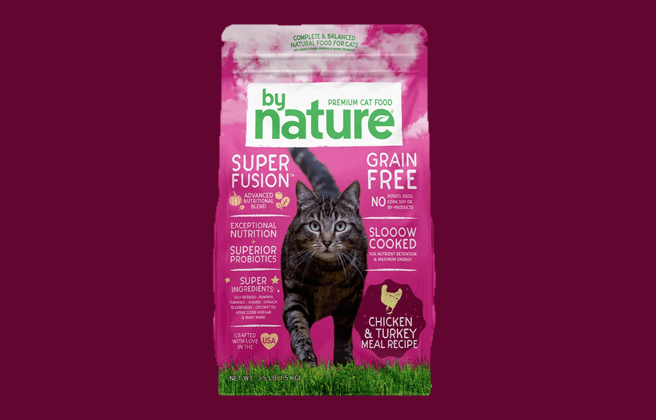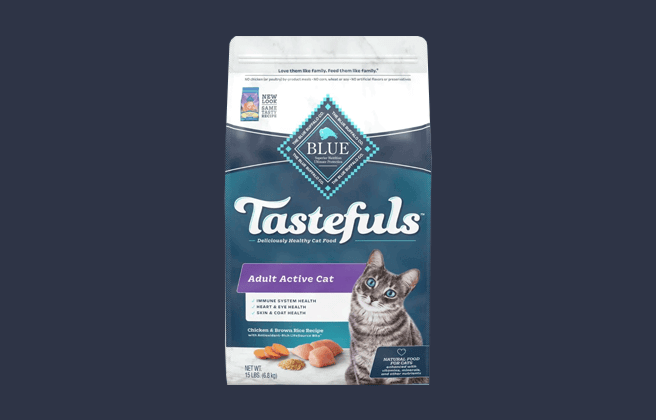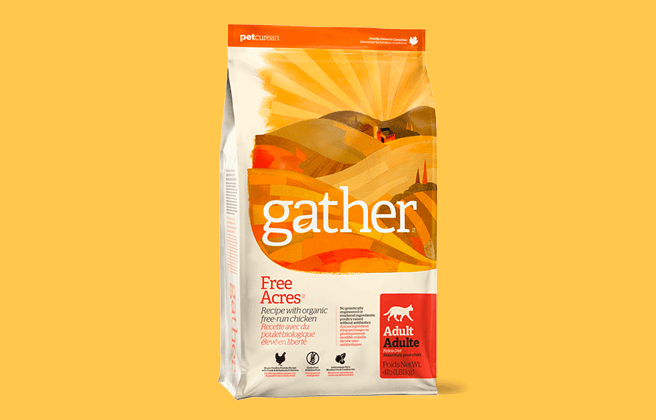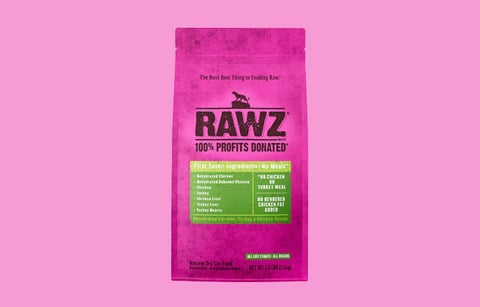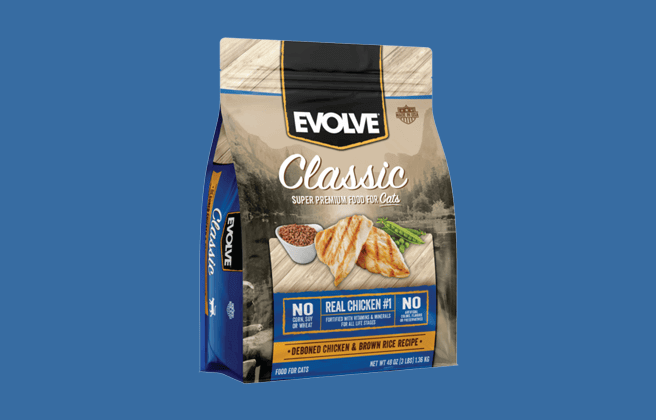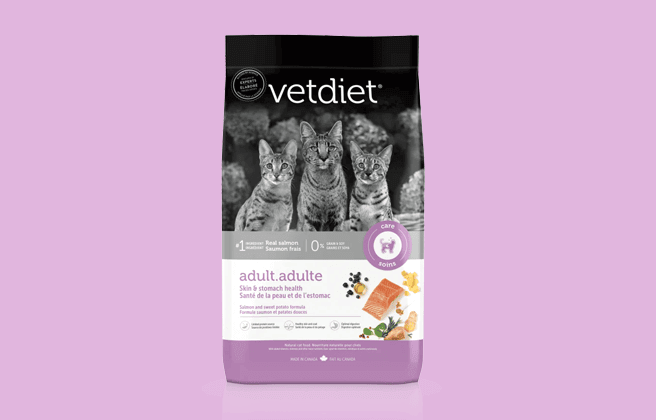
Our Verdict
VetDiet dry product range is made of eight recipes which all receive the Cat Food Advisor rating, 2.5 stars
The range is formulated with the help of an advisory board made up of vets and nutritionists to select ingredients to target the specific needs of cats.
Pros
- Foods are nutritionally complete and balanced
- Affordable
Cons
- Multiple controversial ingredients.
- Low protein levels
- High carbohydrate content
- Plant based proteins
The table below shows each recipe in the range including our rating and the AAFCO nutrient profile: Growth (kitten), Maintenance (adult), All Life Stages, Supplemental or Unspecified.
| Product line | Rating | AAFCO |
|---|---|---|
| VetDiet Adult Skin & Stomach Health, Salmon and Sweet Potato Formula | 2.5 | M |
| VetDiet Kitten, Chicken and Rice Formula | 2.5 | G |
| VetDiet Adult, Chicken and Rice Formula | 2.5 | M |
| VetDiet Adult Indoor, Chicken Formula | 2.5 | M |
| VetDiet Adult Indoor, Salmon Formula | 2.5 | M |
| VetDiet Adult Dental Health, Chicken and Rice Formula | 2.5 | M |
| VetDiet Senior, Chicken and Rice Formula | 2.5 | M |
| VetDiet Adult Weight Control, Chicken and Rice Formula | 2.5 | M |
Recipe and Label Analysis
VetDiet Adult Skin & Stomach Health, Salmon and Sweet Potato formula was selected to represent the other products in the line for a detailed recipe and nutrient analysis.
Label and nutrient data below are calculated using dry matter basis.
VetDiet Adult Skin & Stomach Health, Salmon and Sweet Potato formula
Estimated Dry Matter Nutrient Content
Protein
Fat
CarbsCarbohydrates
Salmon, menhaden fish meal, sweet potatoes, potato meal, potato protein, dried egg product, canola oil (preserved with mixed tocopherols and citric acid), tapioca starch, pea protein, dried tomato pomace, natural flavor, dicalcium phosphate, flaxseed, yeast culture, calcium carbonate, fish oil, sun-cured ground miscanthus grass, sun-cured alfalfa meal, choline chloride, dl-methionine, taurine, vitamin e supplement, l-lysine, yeast extract, chicory root extract, l-carnitine, new zealand green mussels, yucca schidigera extract, fumaric acid, lactic acid, citric acid, malic acid, dried kelp, peppermint leaves, dried spinach, dried carrots, chia seed, dried pomegranate, dried blueberries, dried cranberries, dried apples, dried blackberries, dried broccoli, quinoa, dried pumpkin, dried avocado, dried kale, green tea extract, dried parsley, rosemary extract, thyme extract, carob bean, paprika, ginger, chamomile, turmeric, aloe vera gel concentrate, ferrous sulfate, zinc oxide, zinc proteinate, ascorbic acid (vitamin c), niacin, iron proteinate, manganous oxide, copper sulfate, calcium pantothenate, riboflavin, vitamin A acetate, manganese proteinate, pyridoxine hydrochloride, vitamin B12 supplement, sodium selenite, biotin, thiamine mononitrate, copper proteinate, vitamin D3 supplement, potassium iodate, inositol, folic acid.
Fiber (estimated dry matter content) = 3.5%
Red denotes any controversial items
Ingredients Analysis
The first ingredient is salmon. Salmon is an oily marine and freshwater fish not only high in protein but also omega 3 fatty acids, essential oils needed by every cat to sustain life.
The second ingredient is menhaden fish meal. Because it is considered a meat concentrate, fish meal contains almost 300% more protein than fresh fish itself.
Menhaden are small ocean fish related to herring. They’re rich in protein and omega-3 fatty acids. What’s more, in their mid-depth habitat, menhaden are not exposed to mercury contamination as can be typical with deep water species.
This item is typically obtained from the “clean, dried, ground tissue of undecomposed whole fish and fish cuttings” of commercial fish operations. 1
The third ingredient is sweet potatoes. Sweet potatoes are a gluten-free source of complex carbohydrates in cat food. They are naturally rich in dietary fiber and beta carotene.
The fourth ingredient is potato meal, a dry item made from the by-products of potato processing. In most cases, potatoes can contain about 10% dry matter protein which can have a slight effect on our estimate of the total meat content of this recipe.
The fifth ingredient is dried egg product, a dehydrated form of shell-free eggs. Quality can vary significantly. Lower grade egg-product can even come from commercial hatcheries – from eggs that have failed to hatch.
In any case, eggs are easy to digest and have an exceptionally high biological value.
The sixth ingredient is canola oil. Unfortunately, canola can be a controversial item. That’s because it can sometimes (but not always) be derived from genetically modified rapeseed.
Yet others cite the fact that canola oil can be a significant source of omega-3 fatty acids.
In any case, plant-based oils like canola are less biologically available to a cat than fish oil as a source of quality omega-3 fats.
The seventh ingredient is tapioca starch, a gluten-free, starchy carbohydrate extract made from the root of the cassava plant.
The eighth ingredient is pea protein, what remains of a pea after removing the starchy part of the vegetable.
Even though it contains over 80% protein, this ingredient would be expected to have a lower biological value than meat.
And less costly plant-based products like this can notably boost the total protein reported on the label — a factor that must be considered when judging the meat content of this cat food.
From here the list goes on to include a number of other items. But to be realistic, ingredients located this far down the list (other than nutritional supplements) are not likely to affect the overall rating of the product.
However, this food contains chelated minerals that have been chemically attached to protein. This makes them easier to absorb. Chelated minerals are usually found in better cat foods.
Nutrient Analysis
Based on its ingredients alone, VetDiet Adult Skin & Stomach Health, Salmon and Sweet Potato formula looks like a below-average dry product.
The dashboard displays a dry matter protein reading of 33.3%, a fat level of 16.7% and an estimated carbohydrate level of 42%.
As a group, the brand features a below-average protein content of 34.2% and a near-average fat level of 16.3%. Together these figures suggest a carbohydrate content of 42% for the overall product line, alongside a fat to protein ratio of 47%.
This means this VetDiet dry range contains lower than average protein, higher than average carbohydrate and near-average fat, when compared to typical dry cat food.
Final Word
Whilst the first ingredient listed is animal based protein, there are also plant based proteins included, along with multiple controversial ingredients, which have resulted in a lower star rating.
Has VetDiet cat food been recalled in the past?
No. To the best of our knowledge, VetDiet has never been recalled.
You can view a complete list of all cat food recalls since 2021 here.
To stay on top of any cat food product recalls, sign up for our free email alerts, here.
About
In 1993, the Legault family launched the VetDiet business. The headquarters are based in Anjou, Quebec and the food is manufactured in the United States and Canada.
Best cat foods
We uphold the highest editorial standards when creating the authoritative content pet parents rely on and trust.
Every piece of clinical content on the Cat Food Advisor is reviewed by our certified Veterinary Advisory Board, which consists of licensed veterinarians and medically certified specialists.
Our reviews are completely independent; we are not paid by any pet food company to promote their products favorably. We do not accept money, gifts, samples or other incentives in exchange for special consideration. For more information see our Disclaimer & Disclosure page.







